05 Floating Point Arithmetic
Floating Point¶

\[ x = (-1)^s \times (1.\text{Fraction}) \times 2^{\text{Exponent - Bias}} \]
S¶
- Sign bit
- 0: non-negative
- 1: negative
Exponent¶
- Excess representation: actual exponent + Bias
- Ensures exponent is unsigned
- Single: Bias = 127; Double: Bias = 1023
Normalized Significand¶
- Significand is Fraction with the
1.restored - \(1.0 \le |\text{significand}| < 2.0\)
- Always has a leading pre-binary-point 1 bit, so no need to represent it explicitly (hidden bit)
Single Precision (32-bit)¶
Exponents \(00000000\) and \(11111111\) reserved
| Smallest value | Largest value | |
|---|---|---|
| Exponent | 00000001 | 11111110 |
| actual exponent | –126 | +127 |
| Fraction | 000…00 | 111…11 |
| significand | 1.0 | 2.0 |
| Value | \(±1.0 × 2^{–126} ≈ ±1.2 × 10^{–38}\) | \(±2.0 × 2^{+127} ≈ ±3.4 × 10^{+38}\) |
Double Precision (64-bit)¶
Exponents \(0000…00\) and \(1111…11\) reserved
| Smallest value | Largest value | |
|---|---|---|
| Exponent | 00000000001 | 11111111110 |
| actual exponent | –1022 | +1023 |
| Fraction | 000…00 | 111…11 |
| significand | 1.0 | 2.0 |
| Value | \(±1.0 × 2^{–1022} ≈ ±2.2 × 10^{–308}\) | \(±2.0 × 2^{+1023} ≈ ±1.8 × 10^{+308}\) |
Floating Point Examples¶
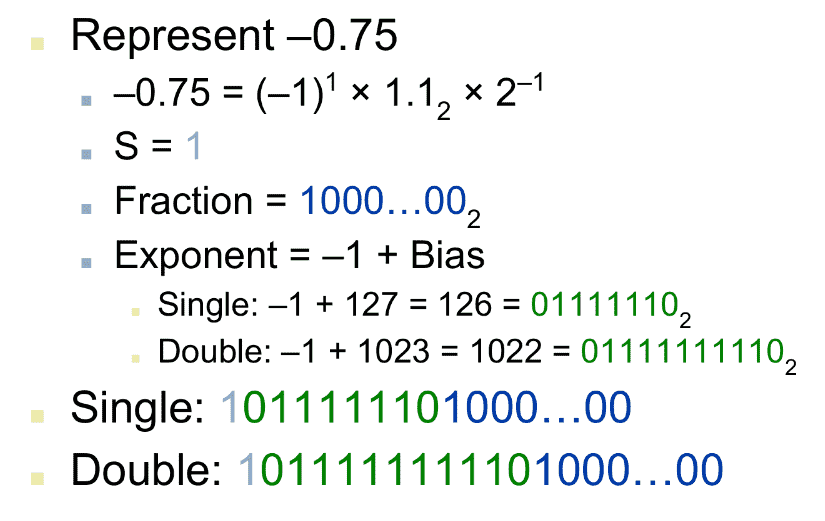
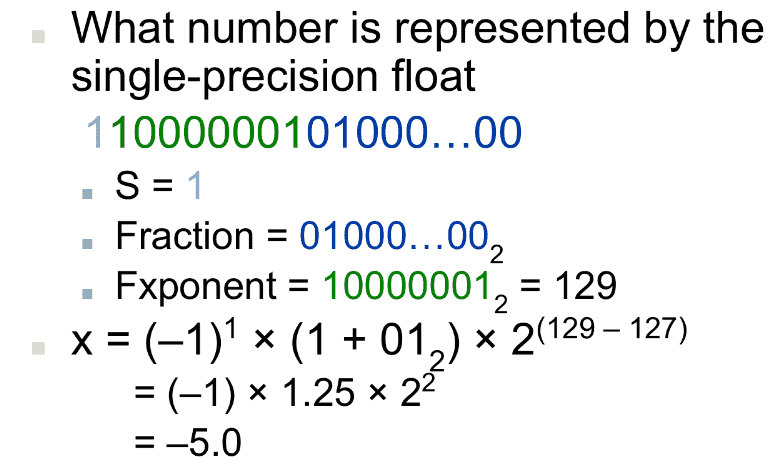
Denormal Numbers¶
Exponent = 000...0 ⇒ hidden bit is 0
\[ x = (-1)^s \times (0+\text{Fraction}) \times 2^{-\text{Bias}} \]
- Smaller than normal numbers
- Allow for gradual underflow, with diminishing precision
Denormal with fraction = 000...0 is \(\pm 0.0\) (2 representations of \(0.0\))
Infinities and NaNs¶
| \(\pm \infty\) | NaN | |
|---|---|---|
| Infinity | Not-A-Number | |
| Exponent | \(111 \dots 1\) | \(111 \dots 1\) |
| Fraction | \(000 \dots 0\) | \(\ne 000 \dots 0\) |
| Can be used in subsequent calculations | ✅ | ✅ |
| Avoids need for overflow check | Indicates illegal or undefined result For eg: \(0/0\) |
Floating-Point Addition¶
- Align binary points Shift number with smaller exponent
- Add significands (in binary)
- Normalize result & check for over/underflow
- Round and renormalize, if necessary
FP Adder Hardware¶
Much more complex than integer adder
Doing it in one clock cycle would take too long
- Much longer than integer operations
- Slower clock would penalize all instructions
FP adder usually takes several cycles
- Can be pipelined
MIPS Floating Point Instructions¶
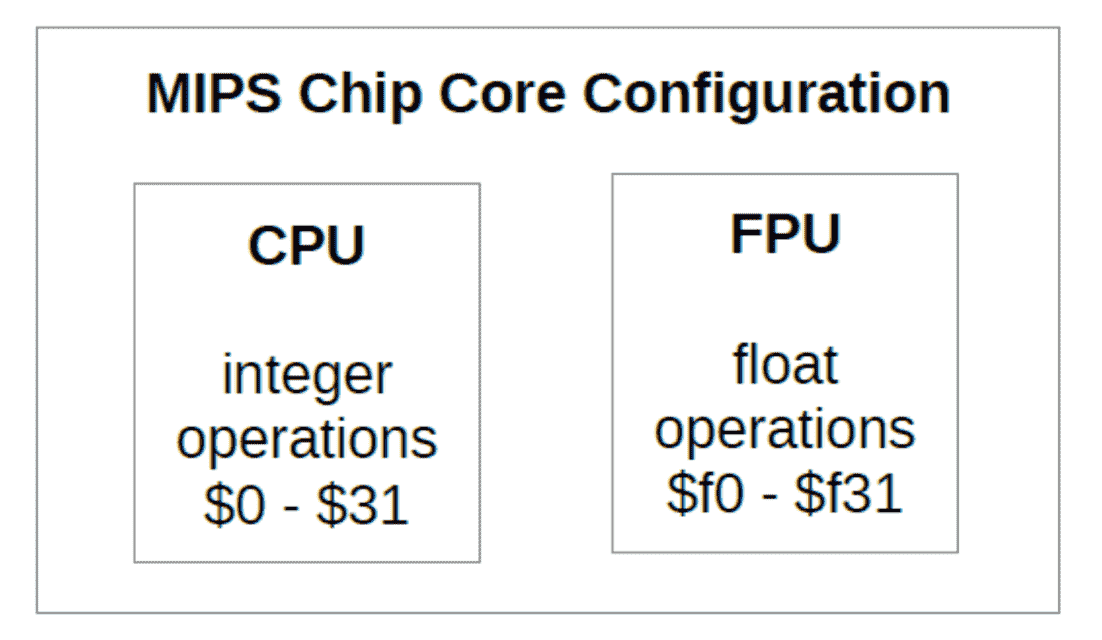
FPU co-processor is an adjunct processor that extends the ISA
Separate FP registers
- 32 single-precision:
$f0, $f1, … $f31 - Paired for double-precision:
$f0/$f1, $f2/$f3,
FP instructions operate only on FP registers
- Programs generally don’t do integer ops on FP data, or vice versa
- More registers with minimal code-size impact
Separate FP instructions for single/double precision
| Precision | Bits | Instruction Extension | Example |
|---|---|---|---|
| Single | 32 | .s | add.s $f0, $f1, $f2 |
| Double | 64 | .d | add.d $f0, $f2, $f4(equivalent to add.d $f0/$f1, $f2/f3, $f4/$f5) |
FP Arithmetic Operations¶
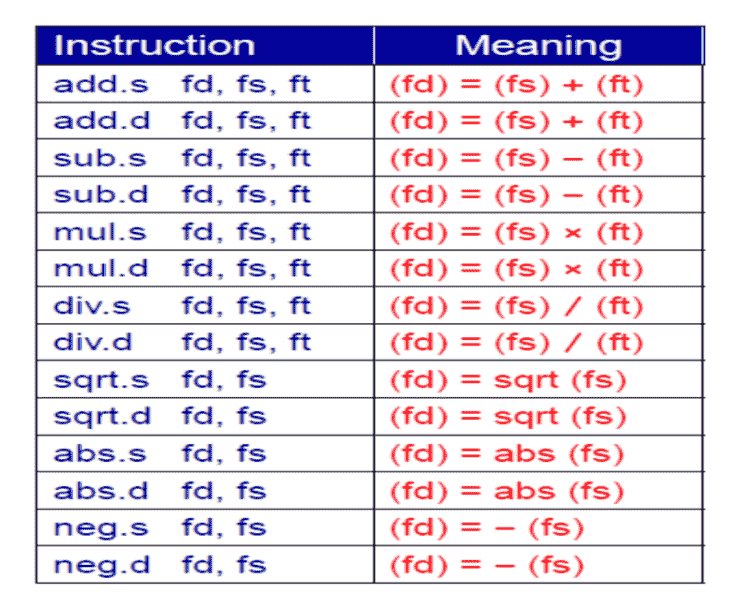
FP Load/Store¶
lwc1 | load word coprocessor 1 |
ldc1 | load double coprocessor 1 |
swc1 | store word coprocessor 1 |
sdc1 | store double coprocessor 1 |
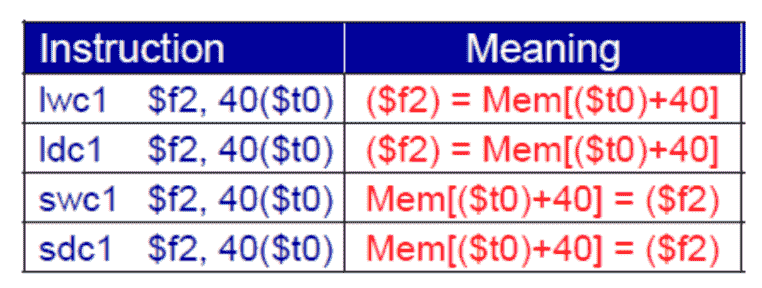
FP Load/Store pseudo Instructions¶
l.s | lwc1 | load FP single |
s.s | swc1 | store FP single |
l.d | ldc1 | load FP double |
s.d | sdc1 | store FP double |
FP Loading immediate value¶
(pseudoinstruction)
FP Data Movement Instructions¶
Moving data between general purpose and FP registers
| Moving data between general purpose and FP registers | mfc1 | move from coprocessor 1 (to general purpose register) |
mtc1 | move to coprocessor 1 (from general purpose register) | |
| Moving data between FP registers | mov.s | move single precision float |
mov.d | move double precision float = even/odd pair of registers |
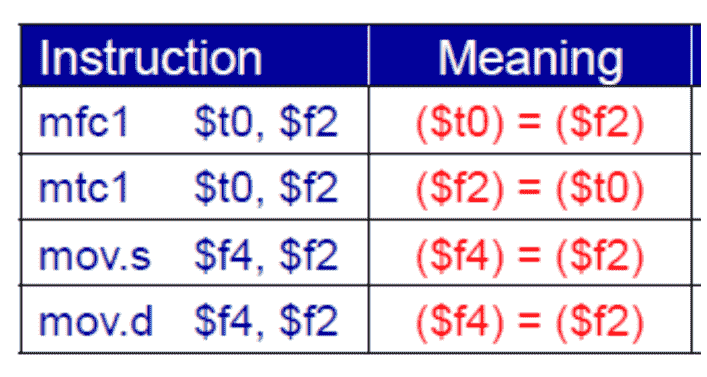
FP Convert Instructions¶
m.x.y
Convert
- to destination format \(x\)
- from source format \(y\)
Supported Formats¶
- Single precision float =
.s(single precision float in FP register) - Double precision float =
.d(double float in even-odd FP register) - Signed integer word =
.w(signed integer in FP register)
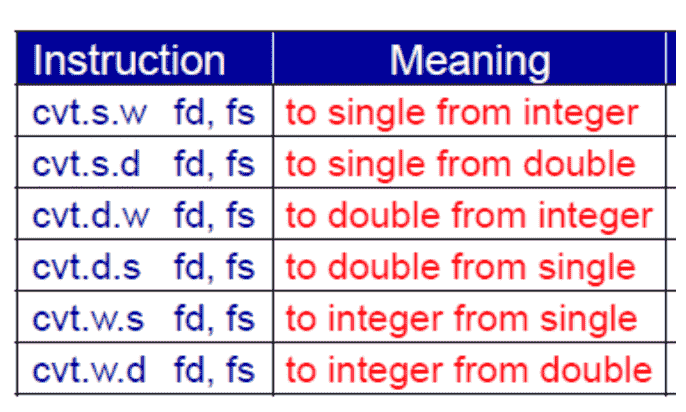
FP Compare and Branch Instructions¶
FP unit (co-processor 1) has a condition flag
- Set to 0 (false) or 1 (true) by any comparison instruction
Three comparisons
- equal, less than, less than or equal
Two branch instructions based on the condition flag
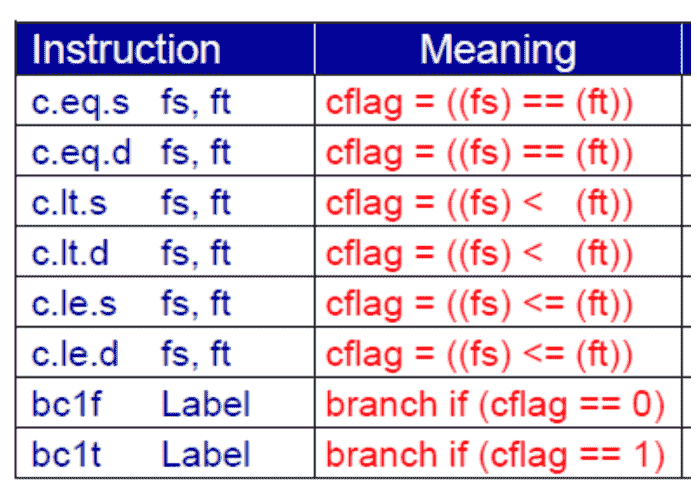
Reading and printing single and double values¶

Floating-Point Data Declarations¶
MIPS Floating Point Examples¶
Area of Circle¶
.data
pi: .double 3.14
.text
main:
#f2,f3 = pi
ldc1 $f2, pi
## read double (radius)
addi $v0, $zero, 7
syscall ## f0, f1 = r
mul.d $f12, $f0, $f0 ## r^2
mul.d $f12, $f2, $f12 ## area = pi * r^2
## print value
addi $v0, $zero, 3
syscall
°F \(\to\) °C¶
.data
const5: .float 5.0
const9: .float 9.0
const32: .float 32.0
constf: .float 50.0
.text
main:
l.s $f16, const5
l.s $f18, const9
div.s $f16, $f16, $f18
l.s $f12, constf
l.s $f18, const32
sub.s $f18, $f12, $f18
mul.s $f12, $f16, $f18
li $v0, 2
syscall
li $v0, 10
syscall
\(ax^2 + bx + c\) for user-inputted \(x\)¶
.data
a: .float 1.0
bb: .float 2.0
c: .float 3.0
msg: .asciiz "Enter x: "
blank: .asciiz " "
newl: .asciiz "\n"
.text
main: ## read input
la $a0,msg ## prompt user for x
li $v0,4 ## print string
syscall
li $v0,6 ## read single
syscall ## $f0 <-- x
## evaluate the quadratic
l.s $f2,a ## sum = a
mul.s $f2,$f2,$f0 ## sum = ax
l.s $f4,bb ## get b
add.s $f2,$f2,$f4 ## sum = ax + b
mul.s $f2,$f2,$f0 ## sum = (ax+b)x = ax^2 +bx
l.s $f4,c ## get c
add.s $f2,$f2,$f4 ## sum = ax^2 + bx + c
## print the result
mov.s $f12, $f2 ## $f12 = argument
li $v0,2 ## print single
syscall
la $a0,newl ## new line
li $v0,4 ## print string
syscall
li $v0,10 ## code 10 == exit
syscall ## Return to OS.